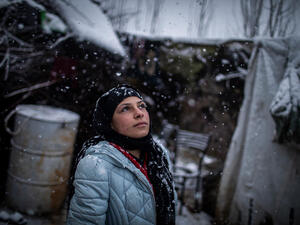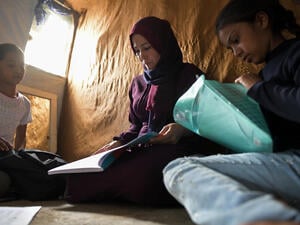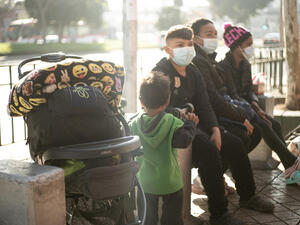Refugees help quake survivors come in from the cold
Refugees help quake survivors come in from the cold

Afghan refugee Abdul Munaf shows Pakistani earthquake survivors in Hassa camp how to put the finishing touches on the mud exhaust pipe of an "Afghan fireplace."
BALAKOT/MUZAFFARABAD, Pakistan, December 22 (UNHCR) - For Afghan men, Abdul Munaf and Dilawar Khan take an uncharacteristic interest in stoves. They go everywhere with one tucked under their arms and constantly adjust it to see how best to protect it.
But Abdul and Dilawar are no galloping gourmets. They are refugees from Afghanistan's Laghman province who are keen to share their stove skills with Pakistanis in need.
"When we first arrived in Pakistan in 1979, we lived in tents like this one," says Abdul, fingering a UNHCR tent in Hassa relief camp near Balakot in Pakistan's North-West Frontier Province. "We had to find a way to keep warm in the winter, but stoves were not really safe because the tent could easily catch fire."
To minimise the risk, he built a fireplace - a mud and brick dome - inside the tent and placed a heating stove under it to keep the flames away from the tent's walls. He also made an exhaust pipe for the smoke. "It is much safer for the stove like this," he says.
The two refugees now live in mud houses in Mansehra's Barary camp and have little need for a firewall. But they are still building the fireplace, travelling from camp to camp to suggest to Pakistan's earthquake survivors how they, too, can stay warm in tents while minimizing the risk of fire.
As Abdul moulds the mud for the fireplace, Hassa camp's residents squat in a circle to see the work in progress. The women look on quietly, while the men poke at the structure and ask how it works. The audience has been invited by a camp management support team from Best, a Pakistani non-government organisation contracted by UNHCR to sensitise camp dwellers on hygiene, fire safety and other day-to-day issues in the camp.
Abdul has so far set up these demonstration tents in six camps in the Mansehra and Balakot areas. Fellow Afghan Dilawar is now in Muzaffarabad, the capital of Pakistan-administered Kashmir, to build several more. Trained as a tailor in Barary camp, the 27-year-old is taking a break from his sewing shop in Mansehra to spread the word on the fireplace.
"I take two hours to make one," says Dilawar, whose own home was slightly damaged in the October 8 earthquake and who - in an unrelated decision - plans to return to Afghanistan with some 60 families from Barary camp next year.
Shaista, a community mobiliser with the Best team, notes: "The women seem really interested in the mud dome, they say they will use it if the men build it."
The "Afghan fireplace" is just one of several ideas being explored to help quake survivors better winterize themselves. Wary of tent fires, the Pakistan authorities have made other proposals, like designing a stove with a protective metal casing, using hot water bottles or heated platforms.
"No method is fool-proof," says UNHCR's acting emergency coordinator for earthquake relief, Indrika Ratwatte. "It's a matter of prioritising which risk is bigger - hypothermia or fire. Ultimately, it's the government's decision, and we'll try to support it as much as we can."
Regardless of the decision, families will likely continue lighting candles or stoves in tents as temperatures dip. To minimize the risk of tent fires, every military-run camp now has several "fire stops" in prominent places, with information on fire prevention, as well as fire extinguishers and pails filled with sand. Camp management support teams are educating people on the safe use of fire while UNHCR's site planners are encouraging more space between tents to contain fires should they break out.
UNHCR also recommends winterization techniques like pitching the tent in a pit about two feet deep to stay close to the warm ground, using plastic sheets as ground sheeting and to insulate the roof of the tent, and using mattresses and blankets for personal insulation.
The refugee agency is now in its latest round of distributing supplies for winterization, providing each person with three blankets and each tent with two plastic sheets and four mattresses. It has already distributed 20,855 tents, 59,236 plastic sheets, 391,759 blankets, 27,938 jerry cans, 22,453 kitchen sets and 12,519 mattresses in the initial phase, and will supplement these supplies with another 77,000 plastic sheets and 250,000 blankets in this round of distribution.
As lead agency of the camp management cluster, UNHCR is supporting the Pakistan authorities and non-government organisations in 36 planned camps. The agency is also improving living conditions in an increasing number of self-settled camps by sending its technical mobile teams to build latrines, communal kitchens and other infrastructure to provide basic services in these camps.
By Vivian Tan in Balakot
and Babar Baloch in Muzaffarabad, Pakistan








